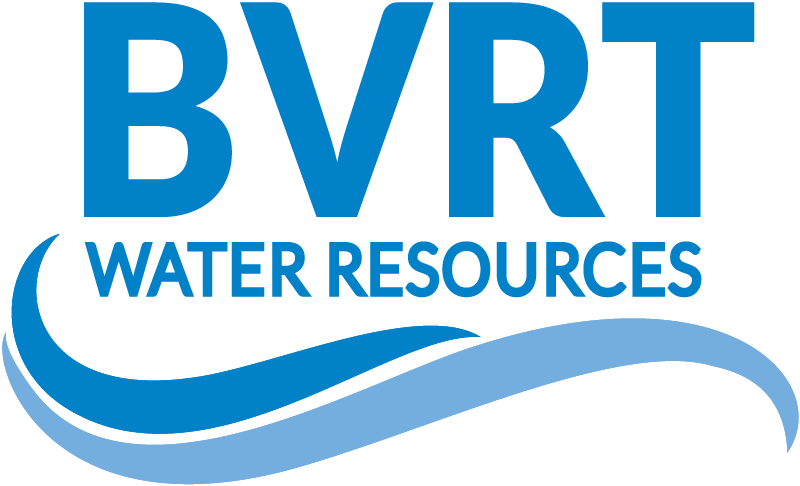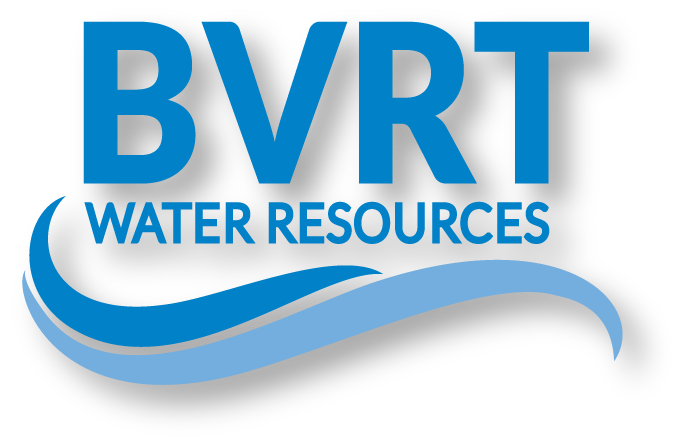Wastewater Treatment And Water Resource Recovery Facilities (WRRFs)
INTRODUCTION
l resource in the world. Municipalities and military installations must manage and steward wastewater from multiple potential sources, including sanitary and household, commercial, institutional, manufacturing, industrial, construction, and storm water. Management and treatment can vary from small onsite treatment and discharge to large-scale water resource recovery facilities with collection systems and pumping stations, treatment processes, oil-water separators, recycling, energy recovery, and reuse.
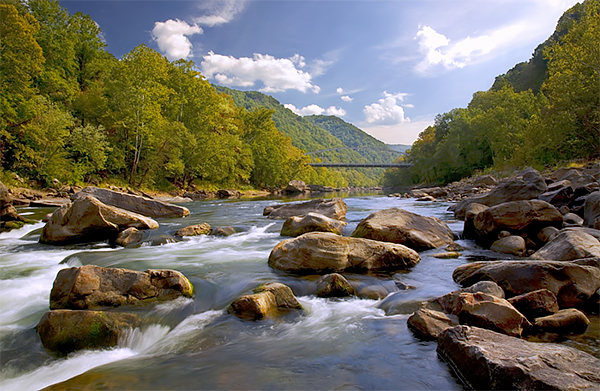
The need for community wastewater collection and treatment systems globally is an evolving one, beginning over 200 years ago in the US. Initially, efforts were focused on collection and disposal and were driven by the need to reduce human disease. That era was followed by a focus on the elimination of gross water pollution effects, allowing native marine organisms to return to normal growth patterns and allowing full human recreational use. Finally, community wastewater collection and treatment systems have begun to redefine wastewater as a resource with valuable products to be extracted through treatment. In the United States wastewater and storm water treatment discharges are governed by the Clean Water Act.
As population and climate pressures increase, safe water and water infrastructure will only become more important. According to the EPA’s 2012 Clean Watersheds Needs Survey, 238.2 million people in the United States were serviced by Publicly Owned Treatment Works (POTW), with a projected increase of over 10% by 2032. In excess of 300 billion cubic meters of municipal wastewater is produced annually in the world. The desire to protect human health, recover and conserve resources while adapting to a changing landscape, including new technologies and aging infrastructure, will drive more advanced wastewater treatment. With the ability to recover valuable resources from wastewater, such as phosphorus, nitrogen, and biogas, as well as conserving water for reuse, drinking, agriculture, cooling or industrial use, POTWs are now aptly referred to as water resource recovery facilities as they continue to recover valuable resources through wastewater treatment.
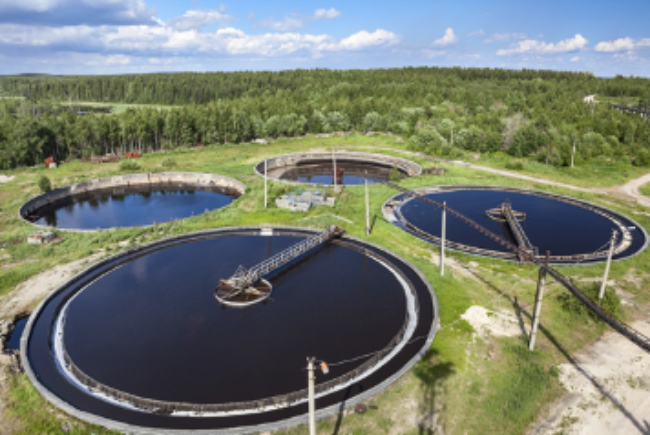
Part of a wastewater treatment facility
DESCRIPTION
Wastewater Collections Systems
Collections Systems refer to the system of underground pipes and maintenance structures that transport wastewater to water resource recovery facilities. These systems include gravity pipes, manholes, lift stations, force mains and more as they collect and transport residential and commercial waste.
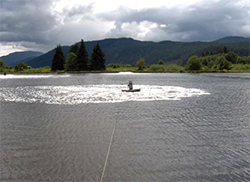
An aerated lagoon
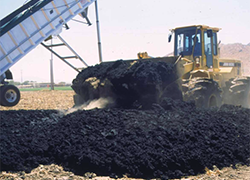
Putting biosolids to work in agriculture
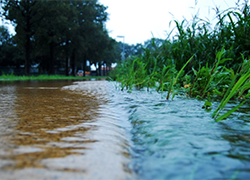
Storm water runoff during an intense storm
Wastewater Treatment Processes
Wastewater treatment refers to the removal of pollutants from wastewater before discharge to a waterbody. This includes physical processes such as sedimentation and filtration, chemical processes such as precipitation and biological processes like aerated lagoons or activated sludge.
Resource Recovery
Water resource recovery facilities present a unique opportunity to reduce energy demands, lower costs and increase production of renewable energy by creating valuable products out of traditional waste streams. For water resource recovery facilities, these resources include water, energy, nutrients (phosphorus and nitrogen) and biosolids.
Biosolids
Biosolids are the nutrient rich organic material resulting from the treatment of domestic waste at a water resource recovery facility. Through biosolids management, solid residue from wastewater treatment is processed to reduce or eliminate pathogens and minimize odors, forming a safe, beneficial agricultural product in accordance with regulatory requirements that can be used as fertilizer and other products.
Storm Water
Storm water refers to a heavy quantity of water, such as rain or snow, that falls to the surface of the Earth which becomes polluted as it picks up, carries, and transports various pollutants (oil, grease, chemicals, sediment, nutrients, pathogens) along streets, drains, open channels, and storm sewer systems. Most of the untreated runoff eventually is discharged into nearby waterbodies. However, in combined sewer systems, storm water flows with wastewater and is treated at a water resource recovery facility.
Oil-Water Separation
Oil-water separation refers to the physical separation of oil-water mixtures into their separate components. Oil-water separators vary widely and are chosen based on performance parameters and operation conditions. Proper oil-water separation is necessary to prevent contamination to storm sewer and sanitary sewer systems.
EMERGING ISSUES
Storm Water
Storm water is a growing source of water pollution in many watersheds across the country. As urban areas grow and severe weather becomes more common, the issue of storm water management will only escalate in importance because of decreases in natural land cover and the expansion of impervious surfaces, such as rooftops, sidewalks and roadways. These surfaces exacerbate runoff because they change the permeability of the landscape — preventing rainwater from soaking in or infiltrating the soil.
Resource Recovery
The concept of a circular economy has steadily been gaining traction in recent years, especially in the water sector, with the idea of taking wastewater and creating valuable products while reducing the amount of waste produced. Water resource recovery facilities (WRRFs) directly contribute to a circular economy by producing clean water, nutrients, renewable energy, and other valuable bio-based materials from wastewater.
Microconstituents
As a result of today’s modern lifestyle and the widespread use of organic chemicals, large amounts of chemical residues from industries, agriculture, and homes are being continuously released in the environment, some of which find their way into municipal wastewater. A few examples of microconstituents that can be found in the environment are pharmaceuticals, personal care and consumer products (PPCPs), pesticides, cleaning materials, chemicals used in building materials, additives in foods and drinks, chemicals used for printing, and more. Although many microconstituents that reach WRRFs are destroyed through wastewater treatment and solids processing, some recalcitrant microconstituents and their metabolites may pass through the treatment process intact and may end up in the effluent or biosolids. In general, wastewater influents contain microconstituents in concentrations ranging from nano-g/L to micro-g/L, in effluent from non-detect to nano-g/L, and in biosolids the concentrations vary from micro-g/kg to mg/kg.
Climate Change
Climate change has directly impacted water resources by altering precipitation patterns, severe drought and floods, snowpack amount, elevation, streamflow, and rising sea levels. This has created a direct need for utilities to manage local water resources to lessen the potential impact of climate change. By increasing water reuse, developing resiliency and other actions, WRRFs can be a leader in fighting and preparing for climate change effects.
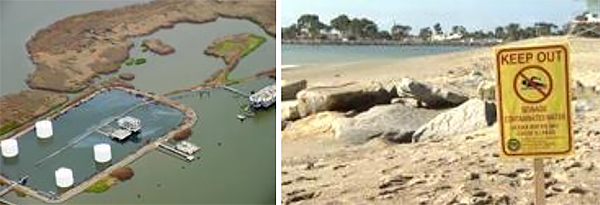
The impacts of climate change can be seen in these two images with flooding and erosion.
Photo Credits: U.S. EPA
Creating Resilient Water Utilities
As extreme weather events become more common, it is ever increasingly important for utilities to increase their resilience to such events. Creating Resilient Water Utilities is an EPA initiative that provides wastewater and storm water utilities with a planning process to improve resilience. It includes a risk assessment, case studies and the tools needed to develop an individualized resilient strategy guide.
Aging Infrastructure
To adequately treat wastewater and manage storm water, the public treatment work systems must continue to operate. As the infrastructure, largely built 50 years ago, begins to age and deteriorate, untreated water will discharge into the environment and the costs to repair will increase rapidly. A proactive, continuous improvement system must be adopted to combat these issues. In addition to ensuring proper wastewater treatment, updating aging infrastructure can create jobs and help offset future lost sales and GDP.
Security and Resilience for the Water Sector: Water and Wastewater Sector Specific Plan
Providing effective wastewater treatment is critical to prevent disease, protect the environment and ensure life and the economy continues as is. To ensure security and resiliency for the water and wastewater sectors, partnerships between public and private utilities, national and state associations, state and local governments, research foundations and federal agencies are necessary. These partnerships must promote collaboration as these organizations prepare to prevent, detect and respond to physical and cyberattacks, other intentional acts and natural disasters.
The Clean Watersheds Needs Survey
The Clean Watersheds Needs Survey is conducted every four years by the EPA, states, territories and the District of Columbia. The survey collects information about publicly owned wastewater collection and treatment facilities, storm water and combined sewer overflows control facilities, non-point source pollution control projects and decentralized wastewater management. The survey provides a thorough examination of the capital costs needed to meet the Clean Water Act standards and address water quality and water quality related public health concerns.
Envision
Envision provides a consensus-based framework to assess sustainability and resilience in wastewater infrastructure. As a program, it defines the sustainable infrastructure standard, incentivizes programs to go above and beyond minimum requirements, recognizes programs that excel and has developed a common language for internal and external partners to clearly communicate. Overall, Envision’s framework ensures sustainable choices are made when planning, designing and constructing infrastructure.
RELEVANT CODES, STANDARDS AND GUIDELINES
- The Clean Water Act
- Earthquake Resilience Guide for Water and Wastewater Utilities
- UFC 3-240-01 Wastewater Treatment and Collection
ADDITIONAL RESOURCES
WBDG
DESIGN OBJECTIVES
Cost-Effective, Sustainable: Optimize Energy Use, Protect and Conserve Water
